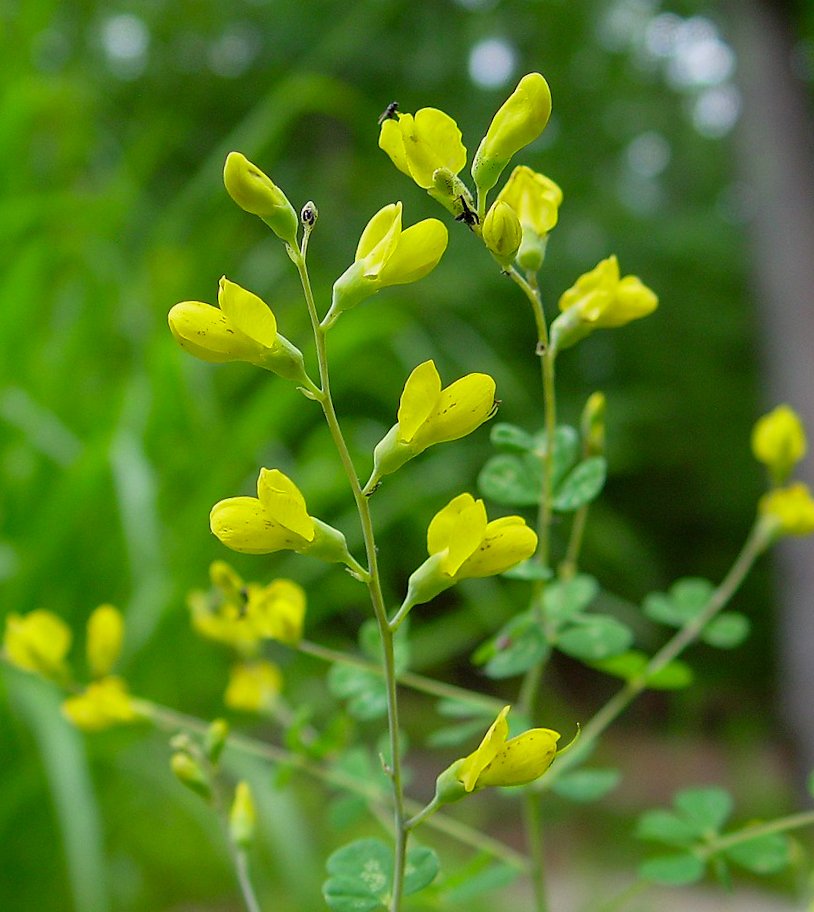 Image 1 of 5
Image 1 of 5

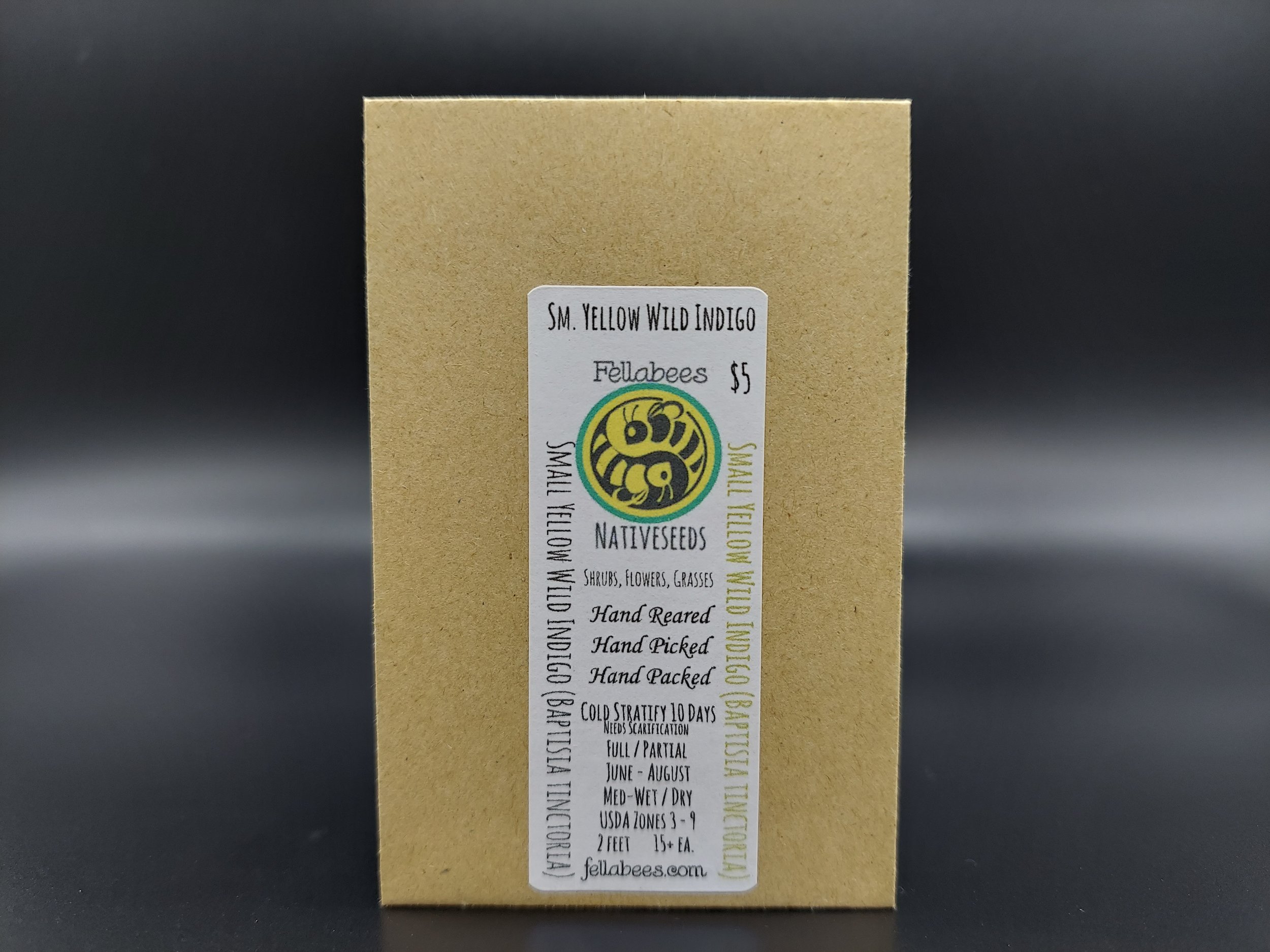 Image 2 of 5
Image 2 of 5

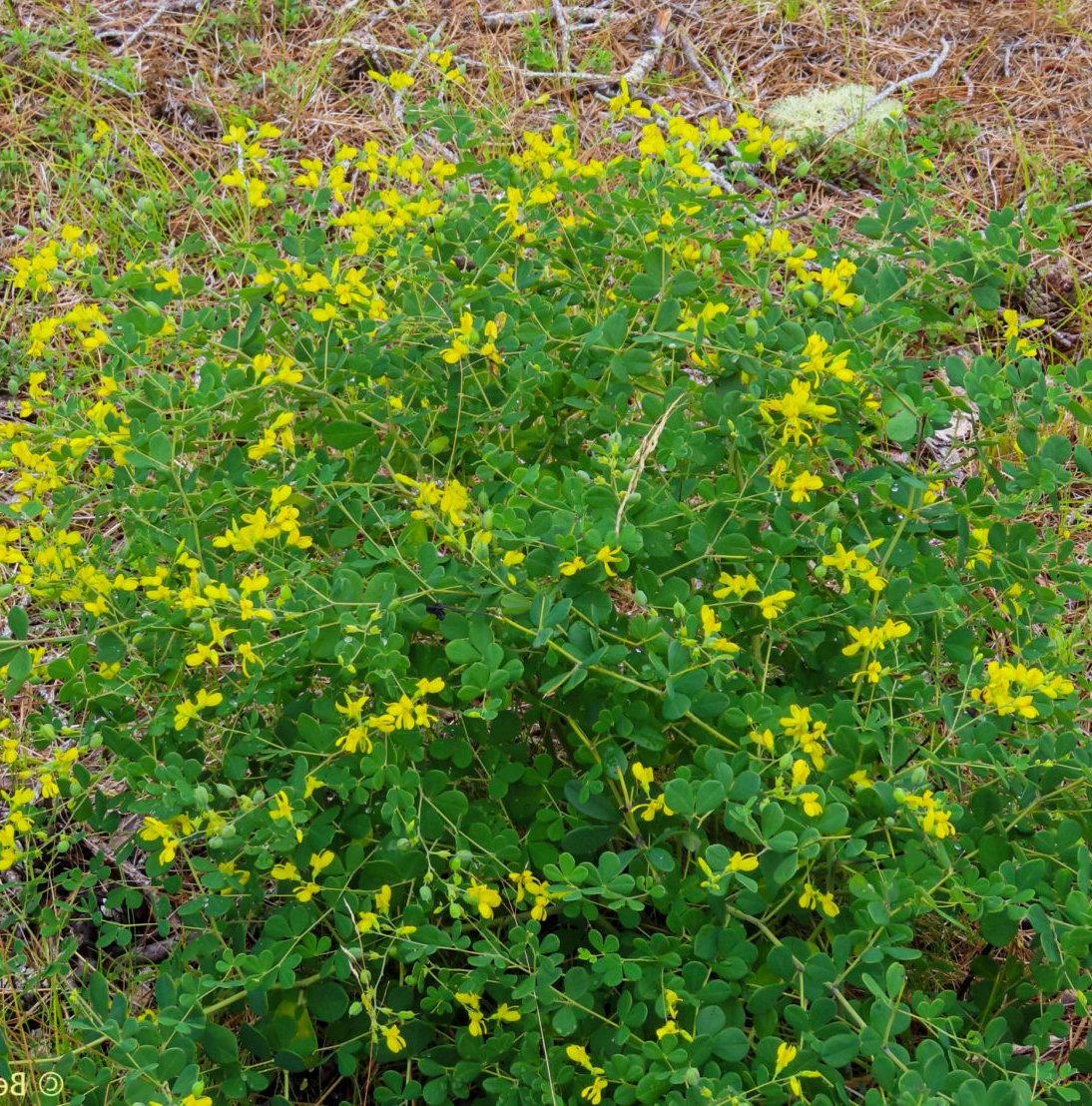 Image 3 of 5
Image 3 of 5

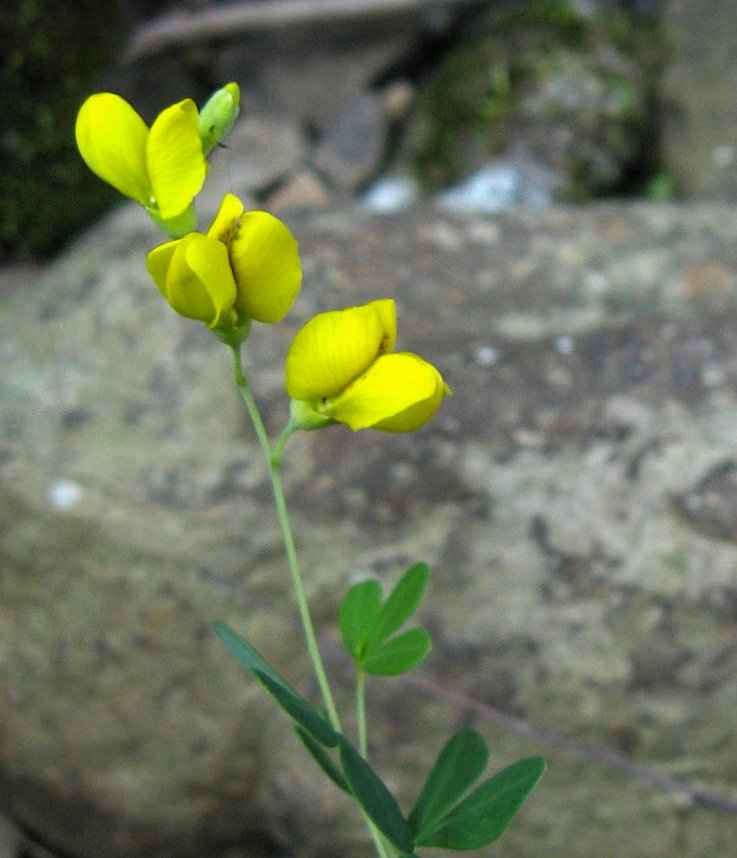 Image 4 of 5
Image 4 of 5

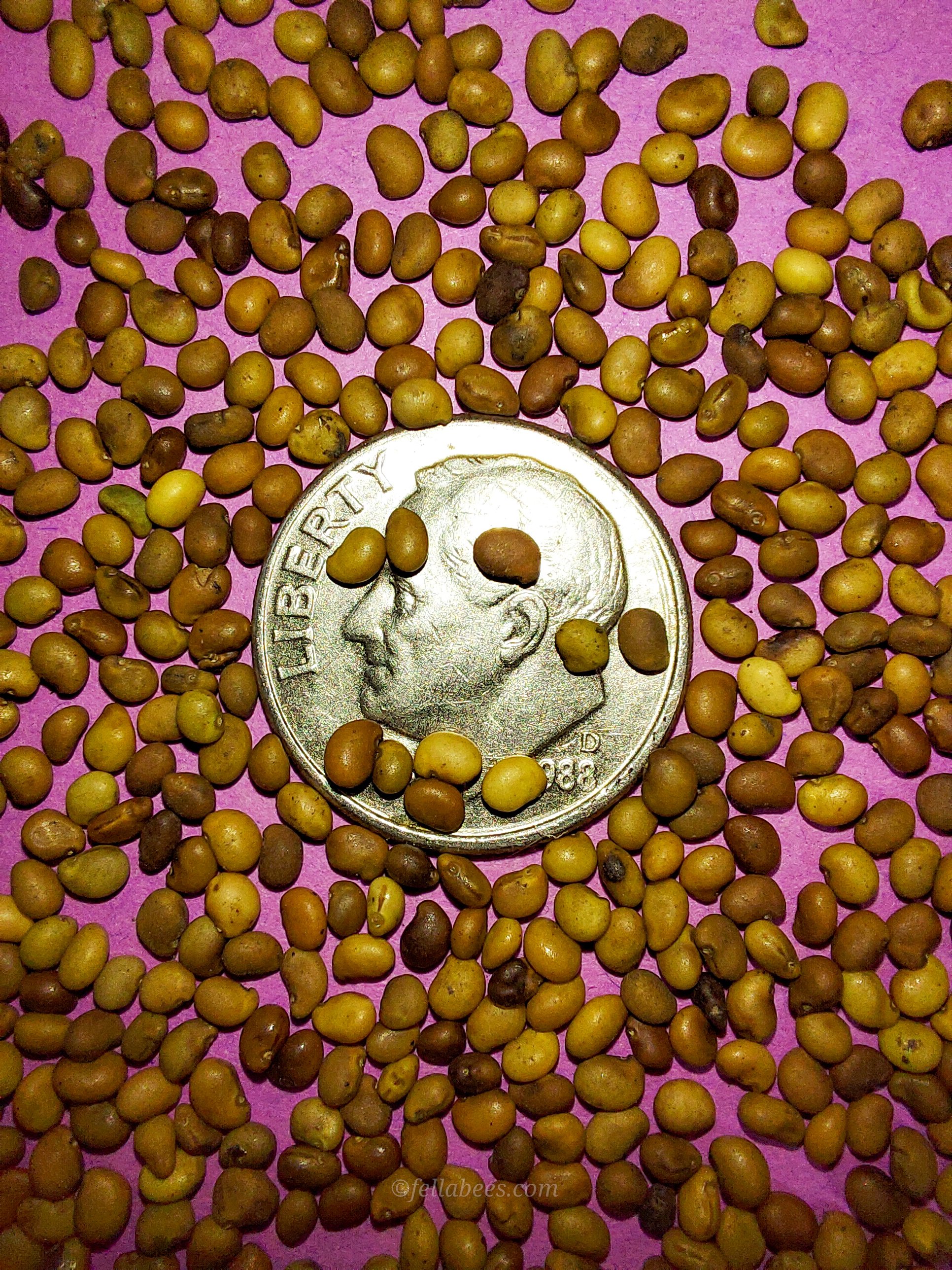 Image 5 of 5
Image 5 of 5






Small Yellow Wild Indigo (Baptisia tinctoria)
Small Yellow Wild Indigo (Baptisia tinctoria)
Baptisia tinctoria is the scientific name for the plant more commonly known as Small Yellow Wild Indigo, also as just Wild-Indigo and much less commonly called Yellow Baptist Tumbleweed, and Horseflyweed.
Small Yellow Wild Indigo is a herbaceous perennial plant in the family Fabaceae. It is native to eastern North America mostly east of the Mississippi River.
Baptisia tinctoria is fairly rare in its native range, found throughout the eastern United States, west to the borders of Wisconsin and Minnesota, and south to the borders of Georgia and Florida. So rare and even extirpated in some parts of its natural range, Baptisia tinctoria is protected by some state authorities such as in Kentucky where it is threatened, in Maine where it is considered endangered, and Iowa where it is extirpated (locally extinct)
The multiple bushy stems of Baptisia tinctoria reach 2 to 3 feet tall. The leaves are silverish green each leaf dividing into three leaflets about ½ inch long. The flowers are yellow and grow in spikes 1½ to 3 inches long.
The leaves are eaten by some lepidopteran (Butterfly and Moth) caterpillars, for example the Io moth (Automeris io). Baptisia tinctoria also plays as host to the Clouded Sulfer Butterfly (Colias philodice) and the Wild Indigo Duskywing Butterfly (Erynnis baptisiae)
Small Yellow Wild Indigo prefers dry meadows and open woodland environments.
In flat and windy native ecosystems Baptisia tinctoria becomes a tumbleweed, since it grows in a globular form and has evolved to break off at the root in the autumn, and tumbles about shattering its pods which each contain only a single seed, in a unique strategy for seed dispersal.
This plant is considered native, present but rare in several counties of the states of Wisconsin, Illinois, Indiana, and Kentucky. This plant is listed as extirpated (locally extinct) in several counties of the states of Iowa, Vermont, and Maine.
Plant Details
USDA Zones: 3-9
Germination Needs: Seed needs scarification before artificial stratification, (Rub seeds between medium grit sandpaper to aerate the seed surface without crushing or opening the seed) 10 Days Cold Stratification. No scarification needed if directly sown.
Life Cycle: Perennial
Sun Exposure: Full to Partial
Soil Moisture: Medium-Wet, Medium, Medium-Dry, Dry
Plant Spacing: 2-3 feet
Height: 2 feet
Bloom time: June, July, August
Bloom Color: Yellow
Advantages :
Pollinator Favorite: butterflies, moths, bees, wasps, beetles.
Deer Resistant: Yes
Native to : Wisconsin, Iowa, Illinois, Indiana, Michigan, Ohio, Pennsylvania, New York, Vermont, New Hampshire, Maine, Massachusetts, Rhode Island, Connecticut, Delaware, Maryland, New Jersey, West Virginia, Virginia, North Carolina, South Carolina, Georgia, Tennessee and Kentucky.
.
.
Packet quantities:
We pride ourselves on ethical, hands on, ecological management, using no mechanical or chemical methods whatsoever.
All of our native seed is hand reared, hand picked, and hand packed from native prairies under our exclusive management, never breaking chain of custody from the field until it is sent to you. Each packet is hand prepared for shipment by us, directly.
Small seed species will contain greater than 20-25 seed
Large seed species will contain greater than 10-15 seed
It is our mission to spread the wealth of native plant and pollinator ecological sustainability, and educate back yard gardeners as well as corporate and government entities in how to germinate, grow, and benefit from native synergies.
Thank you for your support, it is because of you, that we can grow together to do, what we do.🐛🦋🐝🐞🌾🌱🌼🧡
Small Yellow Wild Indigo (Baptisia tinctoria)
Baptisia tinctoria is the scientific name for the plant more commonly known as Small Yellow Wild Indigo, also as just Wild-Indigo and much less commonly called Yellow Baptist Tumbleweed, and Horseflyweed.
Small Yellow Wild Indigo is a herbaceous perennial plant in the family Fabaceae. It is native to eastern North America mostly east of the Mississippi River.
Baptisia tinctoria is fairly rare in its native range, found throughout the eastern United States, west to the borders of Wisconsin and Minnesota, and south to the borders of Georgia and Florida. So rare and even extirpated in some parts of its natural range, Baptisia tinctoria is protected by some state authorities such as in Kentucky where it is threatened, in Maine where it is considered endangered, and Iowa where it is extirpated (locally extinct)
The multiple bushy stems of Baptisia tinctoria reach 2 to 3 feet tall. The leaves are silverish green each leaf dividing into three leaflets about ½ inch long. The flowers are yellow and grow in spikes 1½ to 3 inches long.
The leaves are eaten by some lepidopteran (Butterfly and Moth) caterpillars, for example the Io moth (Automeris io). Baptisia tinctoria also plays as host to the Clouded Sulfer Butterfly (Colias philodice) and the Wild Indigo Duskywing Butterfly (Erynnis baptisiae)
Small Yellow Wild Indigo prefers dry meadows and open woodland environments.
In flat and windy native ecosystems Baptisia tinctoria becomes a tumbleweed, since it grows in a globular form and has evolved to break off at the root in the autumn, and tumbles about shattering its pods which each contain only a single seed, in a unique strategy for seed dispersal.
This plant is considered native, present but rare in several counties of the states of Wisconsin, Illinois, Indiana, and Kentucky. This plant is listed as extirpated (locally extinct) in several counties of the states of Iowa, Vermont, and Maine.
Plant Details
USDA Zones: 3-9
Germination Needs: Seed needs scarification before artificial stratification, (Rub seeds between medium grit sandpaper to aerate the seed surface without crushing or opening the seed) 10 Days Cold Stratification. No scarification needed if directly sown.
Life Cycle: Perennial
Sun Exposure: Full to Partial
Soil Moisture: Medium-Wet, Medium, Medium-Dry, Dry
Plant Spacing: 2-3 feet
Height: 2 feet
Bloom time: June, July, August
Bloom Color: Yellow
Advantages :
Pollinator Favorite: butterflies, moths, bees, wasps, beetles.
Deer Resistant: Yes
Native to : Wisconsin, Iowa, Illinois, Indiana, Michigan, Ohio, Pennsylvania, New York, Vermont, New Hampshire, Maine, Massachusetts, Rhode Island, Connecticut, Delaware, Maryland, New Jersey, West Virginia, Virginia, North Carolina, South Carolina, Georgia, Tennessee and Kentucky.
.
.
Packet quantities:
We pride ourselves on ethical, hands on, ecological management, using no mechanical or chemical methods whatsoever.
All of our native seed is hand reared, hand picked, and hand packed from native prairies under our exclusive management, never breaking chain of custody from the field until it is sent to you. Each packet is hand prepared for shipment by us, directly.
Small seed species will contain greater than 20-25 seed
Large seed species will contain greater than 10-15 seed
It is our mission to spread the wealth of native plant and pollinator ecological sustainability, and educate back yard gardeners as well as corporate and government entities in how to germinate, grow, and benefit from native synergies.
Thank you for your support, it is because of you, that we can grow together to do, what we do.🐛🦋🐝🐞🌾🌱🌼🧡
Small Yellow Wild Indigo (Baptisia tinctoria)
Baptisia tinctoria is the scientific name for the plant more commonly known as Small Yellow Wild Indigo, also as just Wild-Indigo and much less commonly called Yellow Baptist Tumbleweed, and Horseflyweed.
Small Yellow Wild Indigo is a herbaceous perennial plant in the family Fabaceae. It is native to eastern North America mostly east of the Mississippi River.
Baptisia tinctoria is fairly rare in its native range, found throughout the eastern United States, west to the borders of Wisconsin and Minnesota, and south to the borders of Georgia and Florida. So rare and even extirpated in some parts of its natural range, Baptisia tinctoria is protected by some state authorities such as in Kentucky where it is threatened, in Maine where it is considered endangered, and Iowa where it is extirpated (locally extinct)
The multiple bushy stems of Baptisia tinctoria reach 2 to 3 feet tall. The leaves are silverish green each leaf dividing into three leaflets about ½ inch long. The flowers are yellow and grow in spikes 1½ to 3 inches long.
The leaves are eaten by some lepidopteran (Butterfly and Moth) caterpillars, for example the Io moth (Automeris io). Baptisia tinctoria also plays as host to the Clouded Sulfer Butterfly (Colias philodice) and the Wild Indigo Duskywing Butterfly (Erynnis baptisiae)
Small Yellow Wild Indigo prefers dry meadows and open woodland environments.
In flat and windy native ecosystems Baptisia tinctoria becomes a tumbleweed, since it grows in a globular form and has evolved to break off at the root in the autumn, and tumbles about shattering its pods which each contain only a single seed, in a unique strategy for seed dispersal.
This plant is considered native, present but rare in several counties of the states of Wisconsin, Illinois, Indiana, and Kentucky. This plant is listed as extirpated (locally extinct) in several counties of the states of Iowa, Vermont, and Maine.
Plant Details
USDA Zones: 3-9
Germination Needs: Seed needs scarification before artificial stratification, (Rub seeds between medium grit sandpaper to aerate the seed surface without crushing or opening the seed) 10 Days Cold Stratification. No scarification needed if directly sown.
Life Cycle: Perennial
Sun Exposure: Full to Partial
Soil Moisture: Medium-Wet, Medium, Medium-Dry, Dry
Plant Spacing: 2-3 feet
Height: 2 feet
Bloom time: June, July, August
Bloom Color: Yellow
Advantages :
Pollinator Favorite: butterflies, moths, bees, wasps, beetles.
Deer Resistant: Yes
Native to : Wisconsin, Iowa, Illinois, Indiana, Michigan, Ohio, Pennsylvania, New York, Vermont, New Hampshire, Maine, Massachusetts, Rhode Island, Connecticut, Delaware, Maryland, New Jersey, West Virginia, Virginia, North Carolina, South Carolina, Georgia, Tennessee and Kentucky.
.
.
Packet quantities:
We pride ourselves on ethical, hands on, ecological management, using no mechanical or chemical methods whatsoever.
All of our native seed is hand reared, hand picked, and hand packed from native prairies under our exclusive management, never breaking chain of custody from the field until it is sent to you. Each packet is hand prepared for shipment by us, directly.
Small seed species will contain greater than 20-25 seed
Large seed species will contain greater than 10-15 seed
It is our mission to spread the wealth of native plant and pollinator ecological sustainability, and educate back yard gardeners as well as corporate and government entities in how to germinate, grow, and benefit from native synergies.
Thank you for your support, it is because of you, that we can grow together to do, what we do.🐛🦋🐝🐞🌾🌱🌼🧡
